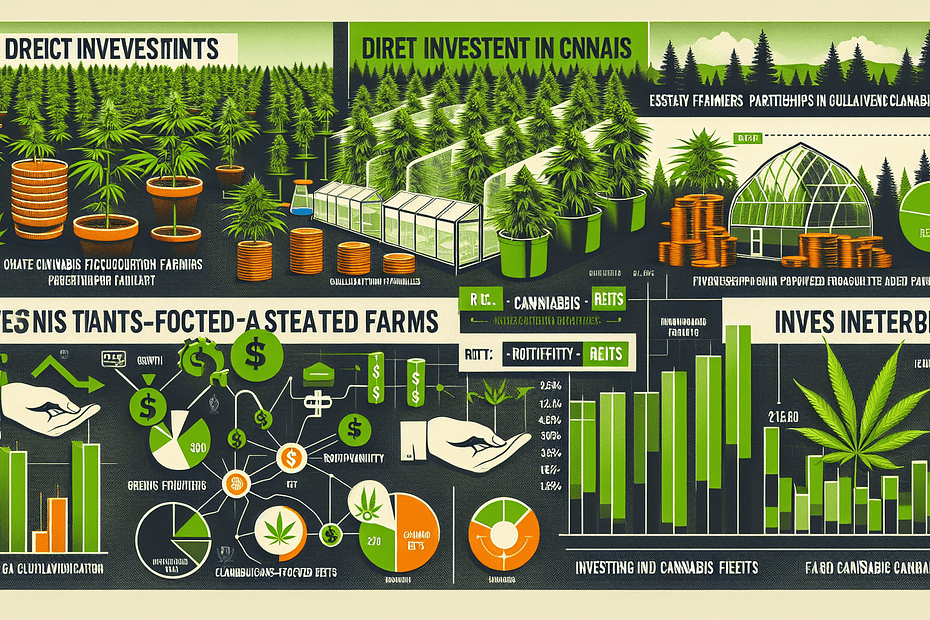So you’re thinking about investing in cannabis farms, huh? Well, you’re not alone. With the rapid growth of the cannabis industry, more and more people are looking to get in on the action. But before you jump in headfirst, it’s important to have a solid strategy in place. In this article, we’ll explore some key strategies for investing in cannabis farms that will help you navigate this booming market and make informed decisions. From understanding the legal landscape to analyzing market trends, we’ve got you covered. So grab your notepad and get ready to learn some valuable tips for investing in cannabis farms.
Understanding the Cannabis Industry
Overview of the cannabis market
The cannabis industry has experienced significant growth and transformation in recent years. With the legalization of cannabis for medical and recreational use in many states and countries, the market has boomed. The industry encompasses various sectors, including cultivation, processing, distribution, and retail. Understanding the dynamics of the cannabis market is essential for investors looking to capitalize on its potential.
Trends and forecasts
The cannabis market is characterized by constantly evolving trends and consumer preferences. Keeping up with these trends is crucial for investors to identify potential investment opportunities. Some current trends in the industry include the rise of alternative consumption methods, such as edibles and vaping, as well as the increasing acceptance and adoption of CBD-based products. Additionally, the market is expected to see further growth as more states and countries move towards legalization.
Legal and regulatory considerations
Investing in cannabis farms requires a thorough understanding of the legal and regulatory landscape. While cannabis is legal for medical or recreational use in certain jurisdictions, it remains illegal at the federal level in many countries, leading to complex legal situations and potential risks. Investors must navigate licensing and permit requirements, as well as stay compliant with evolving regulations. It is crucial to monitor the impact of potential regulatory changes, as they can significantly affect the profitability and viability of cannabis farms.
Identifying Investment Opportunities in Cannabis Farms
Types of cannabis farms
Cannabis farms can be categorized into different types based on cultivation methods, size, and specialization. Outdoor farms, also known as traditional farms, grow cannabis in open fields, relying on natural sunlight and soil. Indoor farms, on the other hand, involve cultivating cannabis in controlled environments, utilizing artificial lighting and hydroponic systems. There are also greenhouse farms that combine aspects of both indoor and outdoor cultivation. Each type of farm has its own advantages and disadvantages, and investors should consider these factors when evaluating investment opportunities.
Factors to consider when evaluating a farm
When assessing a cannabis farm for investment, there are several key factors to consider. One important factor is the location of the farm. Factors such as proximity to suppliers, labor availability, and access to distribution channels can greatly impact the farm’s profitability. Additionally, investors should evaluate the farm’s infrastructure, including the quality of its facilities, equipment, and technology. It is also crucial to assess the expertise and experience of the farm’s management team, as well as their ability to adapt to market trends and navigate regulatory challenges.
Assessing market demand and supply
Understanding the market demand and supply dynamics is crucial for making informed investment decisions. Market research and analysis can help investors identify regions or markets with high demand for cannabis products. It is important to assess factors such as demographics, consumer preferences, and competitor analysis to determine the potential size and growth of the market. Evaluating supply factors, such as the availability of raw materials, production capacity, and distribution networks, is equally important to identify the scalability and sustainability of a cannabis farm investment.
Researching the potential profitability
Investing in cannabis farms requires a careful assessment of potential profitability. Investors should analyze financial statements and evaluate metrics such as revenue growth, profit margins, and return on investment. It is important to consider the farm’s cost structure, including expenses related to cultivation, processing, and distribution. Additionally, assessing the farm’s pricing strategy, market positioning, and competitive advantage can provide insights into its potential profitability. Conducting thorough market research and financial analysis is crucial to ensure that an investment in a cannabis farm aligns with your investment goals and objectives.
Financial Analysis and Risk Assessment
Evaluating the financial health of cannabis farms
Evaluating the financial health of a cannabis farm is crucial to ascertain its stability and potential for growth. Investors should review the farm’s financial statements, including balance sheets, income statements, and cash flow statements, to assess its overall financial performance. Key financial indicators to consider include revenue growth, profitability ratios, liquidity ratios, and solvency ratios. It is also important to evaluate the farm’s financial management practices, including budgeting, expense control, and cash flow management.
Analyzing profitability ratios and metrics
Profitability ratios and metrics provide insights into the farm’s ability to generate profits and sustain its operations. Metrics such as gross profit margin, net profit margin, and return on investment can help investors assess the farm’s profitability relative to its revenues and investments. It is important to compare these metrics with industry benchmarks to understand the farm’s competitive position. Analyzing these ratios over time can also indicate trends and patterns in the farm’s profitability, helping investors make informed investment decisions.
Identifying risks and mitigating strategies
Investing in cannabis farms involves inherent risks, ranging from regulatory challenges to market volatility. It is important for investors to identify potential risks and develop strategies to mitigate them. Some common risks include changes in regulations, supply chain disruptions, competition, and financial risks. Investors should conduct a thorough risk assessment and develop contingency plans to address these risks. Diversifying investments across different farms and regions, maintaining adequate liquidity, and staying informed about industry trends can help mitigate risks in the cannabis industry.
Understanding tax and regulatory implications
The cannabis industry operates within a complex legal and regulatory framework, which includes tax obligations and compliance requirements. Investors must understand the tax implications of investing in cannabis farms, including income taxes, sales taxes, and excise taxes. Depending on the jurisdiction, different tax laws and regulations may apply to cannabis businesses. It is important to consult with tax professionals who specialize in the cannabis industry to ensure compliance and optimize tax strategies.
Diversification and Portfolio Allocation
Benefits of diversifying investment in cannabis farms
Diversification is a key strategy to manage risk and optimize returns in any investment portfolio, including investments in cannabis farms. By diversifying across different types of cannabis farms, investors can reduce their exposure to specific risks associated with a particular farm or cultivation method. Diversification allows for broader exposure to the cannabis industry and its potential for growth, while also spreading the risk across different markets and regions. Investing in a diversified portfolio of cannabis farms can provide a balance between risk and reward.
Allocating funds across different types of farms
When allocating funds across different types of cannabis farms, investors should consider factors such as risk tolerance, investment objectives, and market conditions. Allocating a portion of the portfolio to different types of farms, such as outdoor, indoor, and greenhouse farms, can provide exposure to different cultivation methods and market segments. The allocation should be based on a careful analysis of each farm’s potential profitability, scalability, and competitive advantage. Regular portfolio rebalancing can also help adjust the allocation to reflect changing market conditions.
Balancing risk and reward
Investing in cannabis farms involves balancing risk and reward. Higher-risk investments may offer the potential for higher returns, but they also come with a greater level of uncertainty and volatility. Lower-risk investments may provide stability and consistent returns, but they may have limited growth potential. Finding the right balance between risk and reward is a personal decision based on individual investment goals and risk tolerance. Diversification and thorough analysis of potential investments can help strike a balance and minimize the overall portfolio risk.
Considering geographical diversification
Geographical diversification is an important aspect of portfolio allocation in the cannabis industry. Investing in farms located in different regions or countries can help reduce risk by spreading exposure to specific regulatory and market conditions. Some regions may have more favorable regulations and market dynamics, while others may present higher risks and uncertainties. Considering geographical diversification allows investors to take advantage of regional market trends, minimize regulatory risks, and capitalize on potential growth opportunities in different markets.
Choosing the Right Cannabis Farm
Analyzing management team and expertise
The management team is a critical factor to consider when choosing a cannabis farm for investment. Assessing the team’s expertise, experience, and track record can provide insights into their ability to successfully operate and navigate the challenges of the cannabis industry. Evaluating the management team’s knowledge of cultivation practices, regulatory compliance, and market trends is crucial. Additionally, considering the team’s ability to adapt to changing market conditions and build strategic partnerships can enhance the farm’s chances of success.
Assessing cultivation practices and technology
The cultivation practices and technology employed by a cannabis farm can significantly impact its efficiency, productivity, and profitability. Investors should evaluate the farm’s cultivation methods, including the use of organic practices, pest control measures, and quality control processes. Understanding the technology and automation systems implemented by the farm can provide insights into its ability to optimize resource utilization and scale operations. Farms that adopt sustainable and innovative cultivation practices may have a competitive advantage in the industry.
Understanding the farm’s competitive advantage
Evaluating the farm’s competitive advantage is essential in assessing its long-term viability and potential for success. Factors such as the farm’s brand reputation, product quality, distribution networks, and customer base can create a competitive edge in the market. Additionally, considering the farm’s ability to innovate and adapt to changing consumer preferences can provide a sustainable competitive advantage. Understanding the unique value proposition of the farm and its ability to differentiate itself from competitors is crucial in making informed investment decisions.
Evaluating potential partnerships or collaborations
Investors should consider the potential for partnerships or collaborations when choosing a cannabis farm for investment. Strategic partnerships can enhance the farm’s capabilities, expand market reach, and unlock new growth opportunities. Evaluating the farm’s existing partnerships, such as relationships with suppliers or distributors, can provide insights into its collaborative approach. Additionally, considering the farm’s openness to partnerships and its ability to build mutually beneficial relationships in the industry can be indicative of its growth potential and scalability.
Legal and Regulatory Considerations
Understanding federal and state laws
Investing in cannabis farms requires a thorough understanding of both federal and state laws, as regulations can vary significantly between jurisdictions. While some countries and states have legalized cannabis for medical and/or recreational use, it remains illegal at the federal level in many places. Investors must familiarize themselves with the specific laws and regulations governing cannabis cultivation, processing, distribution, and retail within the jurisdictions they operate in. Staying up to date with changes in legislation is crucial to ensure compliance and mitigate legal risks.
Navigating licensing and permit requirements
Cannabis farms require various licenses and permits to operate legally. The specific requirements can vary depending on the jurisdiction and the type of cultivation. Investors must navigate the licensing process, which typically involves rigorous background checks, security measures, and compliance with specific regulations. Understanding the timeframes, costs, and documentation required for obtaining licenses and permits is essential when evaluating an investment in a cannabis farm. Working closely with legal professionals who specialize in the cannabis industry is advisable to ensure compliance and minimize legal risks.
Staying compliant with evolving regulations
Regulations surrounding the cannabis industry are continuously evolving, making it essential for investors to stay informed and ensure ongoing compliance. Changes in regulations can have a significant impact on the profitability and viability of cannabis farms. It is crucial to continually monitor regulatory updates at both the federal and state levels, and adjust business practices accordingly. Establishing strong compliance protocols, conducting regular audits, and engaging legal expertise can help ensure that the farm remains in compliance with evolving regulations.
Assessing the impact of potential regulatory changes
The cannabis industry is subject to ongoing regulatory changes, which can impact investment decisions. Investors must assess the potential impact of regulatory changes on the profitability and sustainability of cannabis farms. Changes in regulations can affect various aspects, including licensing requirements, product labeling, packaging, and marketing restrictions. Understanding the potential risks and opportunities arising from regulatory changes is crucial in making informed investment decisions. Regularly monitoring legislative developments and engaging with industry associations and professionals can provide valuable insights into potential regulatory changes.
Due Diligence and Research
Conducting thorough background checks
Performing thorough background checks is an essential part of due diligence when considering an investment in a cannabis farm. Investors should research the farm’s ownership structure, management team, and key stakeholders. Evaluating their backgrounds, experience, and track record can help identify any red flags or potential risks. Background checks can include verifying licenses and permits, checking for any legal or regulatory violations, and assessing the reputation of the farm and its key personnel. Consulting with legal professionals specializing in the cannabis industry can provide additional expertise in conducting due diligence.
Reviewing financial statements and audited reports
A comprehensive financial analysis is crucial when evaluating potential investments in cannabis farms. Investors should review the farm’s financial statements, including balance sheets, income statements, and cash flow statements. Analyzing these statements can provide insights into the farm’s financial health, including its profitability, liquidity, and solvency. It is also advisable to review audited reports, if available, to verify the accuracy and reliability of the financial information. Engaging the services of an independent auditor can provide additional assurance and expertise in reviewing financial statements.
Examining market research and analysis
Market research and analysis are essential in understanding the potential profitability and market dynamics of cannabis farms. Investors should review reports, studies, and market analysis related to the cannabis industry. Analyzing factors such as market size, growth rates, consumer trends, and competitive landscape can provide insights into the market opportunities and risks. Additionally, evaluating consumer surveys and market segmentation studies can help investors identify target demographics and potential demand for specific cannabis products. Conducting independent market research or seeking professional advice can provide a more comprehensive understanding of market dynamics.
Seeking professional advice and guidance
Investing in cannabis farms can be complex, and seeking professional advice and guidance is essential. Engaging legal professionals who specialize in the cannabis industry can help navigate the complex legal and regulatory landscape. Consulting with financial advisors and analysts can provide insights into financial analysis, risk assessment, and investment strategies. Considering the expertise of professionals such as auditors, tax consultants, and market research analysts can enhance due diligence efforts and provide a more comprehensive understanding of the investment opportunity.
Risk Management Strategies
Implementing a risk management framework
Investing in cannabis farms involves managing various risks, including regulatory, operational, financial, and market risks. Implementing a risk management framework is crucial to identify, assess, and mitigate these risks. Establishing robust risk management policies and procedures can help monitor and control risks effectively. This includes conducting regular risk assessments, developing contingency plans, and setting risk tolerance levels. It is important to involve key stakeholders and experts in the risk management process to ensure a comprehensive and structured approach to risk mitigation.
Developing robust contingency plans
Having robust contingency plans in place is essential to prepare for unexpected events or adverse circumstances. Investors should consider potential risks, such as changes in regulations, supply disruptions, or financial downturns, and develop contingency plans to mitigate their impact. This can include diversifying investments, maintaining adequate liquidity, building strategic partnerships, and establishing alternative distribution channels. Regularly reviewing and updating contingency plans is important, considering the evolving nature of the cannabis industry and the risks associated with it.
Monitoring industry trends and market conditions
Staying informed about industry trends and market conditions is crucial for effective risk management. Monitoring industry publications, attending conferences and events, and engaging with industry associations can provide insights into market trends, emerging risks, and best practices. Tracking market conditions, including supply and demand dynamics, pricing trends, and regulatory changes, can help investors anticipate potential risks and opportunities. Being proactive in monitoring industry trends and market conditions allows for timely adjustments to investment strategies and risk mitigation plans.
Staying informed and adapting to changing circumstances
The cannabis industry is constantly evolving, with new regulations, market trends, and consumer preferences emerging. It is important for investors to stay informed about these changes and be adaptable in their investment approach. Regularly engaging with industry professionals, attending educational webinars or seminars, and participating in industry forums can enhance knowledge about the cannabis industry. Being open to adjusting investment strategies and adapting to changing circumstances allows for more effective risk management and capitalizing on emerging opportunities.
Long-Term vs. Short-Term Investment Strategies
Understanding the benefits and drawbacks
Investors must consider the benefits and drawbacks of both long-term and short-term investment strategies when investing in cannabis farms. Long-term strategies involve holding investments for an extended period, often several years, with the goal of capital appreciation and compounding returns. Short-term strategies, on the other hand, aim to generate quick profits through opportunistic trades or market timing. Long-term strategies offer the advantage of potential higher returns and reduced transaction costs, while short-term strategies provide the flexibility to capitalize on short-term market fluctuations.
Factors influencing investment horizon
Several factors can influence the investment horizon when investing in cannabis farms. These include investment goals, risk tolerance, market conditions, regulatory uncertainties, and liquidity requirements. Investors with long-term goals, such as retirement planning or wealth preservation, may opt for a longer investment horizon. Conversely, investors with short-term goals, such as capital growth or income generation, may prefer a shorter investment horizon. It is important to align the investment horizon with the investment goals and adjust it based on changing market conditions or personal circumstances.
Developing an exit strategy
Having an exit strategy is critical in maximizing returns and managing risks when investing in cannabis farms. An exit strategy outlines the planned approach to exit the investment, whether through a sale, merger, or public offering. The strategy should consider factors such as market conditions, valuation expectations, liquidity requirements, and regulatory considerations. Developing a clear exit strategy allows investors to proactively manage their investments, capture profits during favorable market conditions, and minimize potential losses or risks associated with prolonged holding periods.
Assessing liquidity and capital requirements
Investing in cannabis farms can require significant capital, and investors must assess their liquidity and capital requirements. Liquidity refers to the ability to convert an investment into cash quickly without incurring substantial losses. Investments in cannabis farms may have limited liquidity, especially in the early stages, due to regulatory restrictions or a lack of secondary markets. Assessing liquidity requirements, including short-term cash needs and potential emergency funds, is essential to ensure financial stability and avoid strained financial situations when investing in illiquid assets like cannabis farms.
Building a Network and Industry Connections
Attending industry conferences and events
Attending industry conferences and events is a valuable way to build a network and establish connections in the cannabis industry. These events provide opportunities to meet industry experts, learn about the latest trends and developments, and engage with potential partners or collaborators. Networking with industry professionals, investors, and entrepreneurs can provide valuable insights, open doors to new investment opportunities, and foster knowledge sharing. Regular attendance at industry conferences and events allows investors to stay connected with industry dynamics and build a strong network within the cannabis community.
Joining cannabis organizations and associations
Joining cannabis organizations and associations is another way to build industry connections and stay informed about industry developments. These organizations provide a platform for networking, learning, and collaborating with like-minded individuals and businesses in the cannabis industry. Associations can also provide access to industry resources, research reports, and educational materials. Participating in industry-specific organizations and associations allows investors to enhance their knowledge, stay up to date with industry news, and gain credibility within the cannabis community.
Building relationships with key stakeholders
Building relationships with key stakeholders in the cannabis industry is crucial for successful investment in cannabis farms. This includes cultivators, processors, distributors, and retail operators. Engaging in open and transparent communication, attending industry events, and fostering collaboration can help establish strong relationships with these key players. Building trust and credibility within the industry can provide access to insider information, partnership opportunities, and potential referrals to high-quality cannabis farms. Nurturing relationships with key stakeholders allows investors to tap into their expertise and insights, enhancing investment decision-making.
Seeking opportunities for collaboration and knowledge sharing
The cannabis industry is characterized by collaboration and knowledge sharing. Investors can seek opportunities to collaborate with other industry participants, such as researchers, scientists, and entrepreneurs. Collaborating on research projects, sharing best practices, and participating in industry working groups can provide valuable insights and enhance the overall investment strategy. Seeking opportunities for collaboration and knowledge sharing ensures that investors are well-informed about the latest advancements, cutting-edge technologies, and emerging trends in the cannabis industry.





